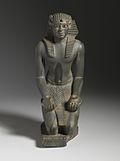Pharaoh
In ancient Egypt, pharaohs were both the heads of state and the religious leaders of their people. The word “pharaoh” means “Great House,” a reference to the palace where the pharaoh resided. While early Egyptian rulers were called “kings,” over time, the name “pharaoh” stuck.
| Pharaoh of Egypt | |
|---|---|
 | |
 | |
| Details | |
| Style | Five-name titulary His Majesty |
| First monarch | King Narmer or King Menes (by tradition)
(first use of the term pharaoh for a king, rather than the royal palace, was c.1210 B.C. with Merneptah during the nineteenth dynasty) |
| Last monarch |
|
| Formation | c. 3150 BC |
| Abolition | |
| Residence | Varies by era |
| Appointer | Divine right |
| ||
| pr-ˤ3 "Great house" in hieroglyphs |
|---|
| ||||||||||||||
| nswt-bjt "King of Upper and Lower Egypt" in hieroglyphs |
|---|
As the religious leader of the Egyptians, the pharaoh was considered the divine intermediary between Egyptians and their gods. Maintaining religious harmony and participating in ceremonies were part of the pharaoh’s role as head of the religion. As a statesman, the pharaoh made laws, waged war, collected taxes, and oversaw all the land in Egypt (which the pharaoh owned).
After their deaths, many pharaohs were entombed and surrounded by riches they were meant to use in the afterlife. Explorers and archaeologists have discovered these tombs and learned a great deal about ancient Egyptian society from them. One very famous example happened in 1922, when archaeologist Howard Carter discovered the tomb of King Tutankhamen, a pharaoh who was assassinated when he was only nineteen years old.
The Ancient Greeks and (later Romans) were big fans of the Egyptians. They were an incredibly ancient civilisation; the only one to survive the Bronze Age Collapse intact, and held legends and records going back three centuries before Ancient Rome come to Conquering them along with Persian Empire.:
[3].:
Famous pharaohs
Menes
Scholars have considered Menes (also called Narmer) the unifier of Egypt and founder of the First Dynasty. He ruled during the Early Dynastic Period. Many scholars believe he was the first ruler to unite upper and lower Egypt (this is why pharaohs hold the title of “lord of two lands”).
Hatshepsut
Pharaohs were typically male, but there were some noteworthy female leaders. Hatshepsut was the fifth pharaoh of the Eighteenth Dynasty of Egypt. She came to the throne in 1478 BC and was the second historically confirmed female pharaoh.
She was a successful ruler, but many inscriptions and monuments about her were destroyed after her death—perhaps to stop future women from becoming pharaohs.
Masks of Hatshepsut present the idealized forms of her face, with perfect symmetrical features.
King Tutankhamun
King Tutankhamun ruled between 1334 - 1325 BC. He was the last of his royal family to rule during the end of the 18th Dynasty.
Cleopatra VII
Cleopatra VII was the queen of the Ptolemaic Kingdom of Egypt, an ancient Hellenistic state. Cleopatra’s leadership helped delay the fall of Egypt to the Roman Empire.
Amenhotep III
Amenhotep III was the ninth pharaoh of the Eighteenth Dynasty. He ruled Egypt from June 1386 to 1349 BC. He reigned during the peak of Egypt's artistic and international power.
Ramesses III
Ramesses III was the second Pharaoh of the Twentieth Dynasty in Ancient Egypt. He reigned from 1186 to 1155 BC. Scholars believe he was the last great monarch of the New Kingdom to hold power over Egypt.
Thutmose I
Thutmose I was the third pharaoh of the eighteenth Dynasty of Egypt. Thutmose I campaigned deep into the Levant and Nubia, pushing the borders of Egypt farther than before.
Pepi I Meryre
Pepi I Meryre was the third king of the Sixth Dynasty of Egypt. He ruled for over forty years during the 24th and 23rd centuries BC, towards the end of the Old Kingdom Period.
King Userkaf
Userkaf was the founder of the Fifth Dynasty. He reigned during the Old Kingdom Period for seven to eight years in the early 25th century BC. It is believed that Userkaf may have been a high priest of Ra before ascending to the throne.
Djedefre
Djedefre ruled in the 4th Dynasty during the Old Kingdom. He took over the throne from his father, Khufu, the builder of the Great Pyramid of Giza.
Nefertiti & Ahkenaten
Pharaoh Akhenaten and Queen Nefertiti ruled during the 18th Dynasty of Ancient Egypt. They believed in only one god - Aten, the disc of the sun - and together they led a religious revolution in Egypt.
Pharaoh Media
The Mask of Tutankhamun from tomb KV62 in the Valley of the Kings. Pharaohs' tombs were provided with vast quantities of wealth
Hatshepsut was the fifth pharaoh of the Eighteenth Dynasty and one the few women pharaohs in Ancient Egypt
Beaded scepter of Khasekhemwy, c. 2890–2680 BCE, Museum of Fine Arts, Boston
Uraeus depicted on king Den, ivory label found at his tomb in Abydos, c. 3000 BCE, British Museum, London
Statuette of Pepy I (c. 2338–2298 BCE) wearing a nemes headdress Brooklyn Museum, New York
Khepresh crown on Akhenaten, 18th dynasty
Nomen and prenomen of Ramesses III
Related pages
References
- ↑ 1.0 1.1 Clayton 1995[broken anchor], p. 217. "Although paying lip-service to the old ideas and religion, in varying degrees, pharaonic Egypt had in effect died with the last native pharaoh, Nectanebo II in 343 BC"
- ↑ 2.0 2.1 von Beckerath, Jürgen (1999). Handbuch der ägyptischen Königsnamen. Verlag Philipp von Zabern. pp. 266–267. ISBN 978-3422008328.
- ↑ https://www.reddit.com/r/AskHistory/comments/wsfg5g/were_ancient_greeks_and_ancient_egyptians_aware/





